Hello everyone, I’m Michael Zhang, a seasoned Chinese traveler who has explored the world and developed a deep passion for cultural journeys. Over the years, I’ve wandered through ancient towns and modern cities across China, always trying to understand the soul of each place through its history. To me, Shanghai is far more than a symbol of modernity—it’s a city steeped in centuries of traditions and beliefs. Today, I’d like to take you to one of its most spiritual and fascinating corners—the City God Temple of Shanghai, a place where faith, history, and local life meet in perfect harmony.
Summary
About City God Temple of Shanghai
The City God Temple of Shanghai, also known as the Old City God Temple, is one of the city’s most famous Taoist temples. Most visitors come here for the legendary snacks and lively atmosphere, but few realize that just south of Yu Garden, there stands a serene temple with deep historical roots.
After enjoying the local delicacies, it’s worth taking a quiet stroll into this sacred space to experience the city’s religious culture firsthand. The temple complex includes nine main halls: the Main Hall, Jiazi Hall, God of Wealth Hall, Cihang Hall, City God Hall, Goddess Hall, Parents Hall, Guan Sheng Hall, and Wenchang Hall. Together with the snack street, Lotus Pond, Huxin Pavilion, and Nine-Bend Bridge, the area forms a vibrant cultural landmark of Shanghai’s Old Town.
- Address: No. 249 Fangbang Middle Road, Huangpu District, Shanghai (Apple Maps / Amap)
- Opening Hours:
- May to September: 9:00 AM – 5:00 PM
- October to April: 8:30 AM – 4:30 PM
- Suggested Visiting Time: 1 hour
- Best Season to Visit: All year round
- Ticket Price: 10 CNY
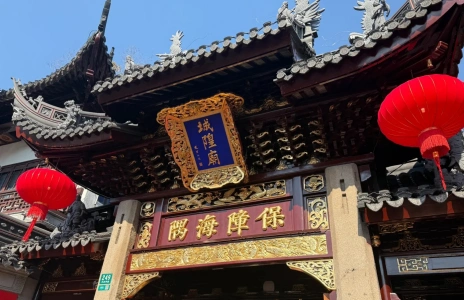
City God Temple Map
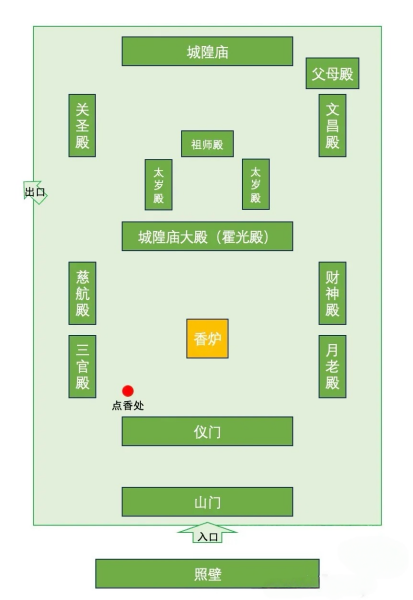
Why You Should Visit City God Temple of Shanghai
Historical Depth and Architectural Features
The City God Temple of Shanghai was originally built during the Yongle reign of the Ming Dynasty (1403–1424). Its main buildings are arranged along a central axis, including the Main Hall, Yuanchen Hall, and Parents Hall, with a color palette of red and dark green and traditional gabled roofs that embody the Ming architectural style. The surrounding alleys retain the charm of Jiangnan’s water-town atmosphere and the nostalgic Shikumen-style architecture, representing the authentic spirit of old Shanghai life.
Folk Culture and Traditional Festivals
Every year, the temple hosts the “Three Parades” during Qingming, the Ghost Festival, and the first day of the tenth lunar month. These events blend ancient rituals with local commerce, once serving as major celebrations across the city. Today, the preserved temple complex, along with nearby snack stalls and teahouses, continues to represent the unique identity of Shanghai’s Old Town culture.
Modern Commerce and Travel Experience
The area around the temple remains a lively commercial hub. Inside the Yu Garden Bazaar, you’ll find time-honored restaurants and classic snacks like Nanxiang steamed buns and pear syrup candy. Although prices may be slightly higher, the chance to taste authentic flavors while soaking up traditional vibes makes it a worthwhile experience for every visitor exploring Shanghai’s cultural heritage.
Top Things to Do in City God Temple of Shanghai
Main Halls
Huo Guang Hall
As you enter the City God Temple of Shanghai, the first thing that catches your eye is the golden plaque above the main gate bearing the words “City God Temple.” Inside stands the statue of Huo Guang, the Marquis of Boluo from the Han Dynasty, honored as the Guardian Deity of Jinshan. Known for his loyalty and wisdom in serving Emperors Zhao and Xuan, Huo Guang remains a revered figure in Chinese history. To his left sits the Civil Judge, to his right the Military Judge—symbols of fairness and moral order. Behind them are the deities Ri Xun (Day Patrol) and Ye Cha (Night Inspection), followed by eight attendants known as Ba Zao Li, who enforce divine justice. The solemn arrangement and lingering incense fill the hall with an atmosphere of awe and reverence.
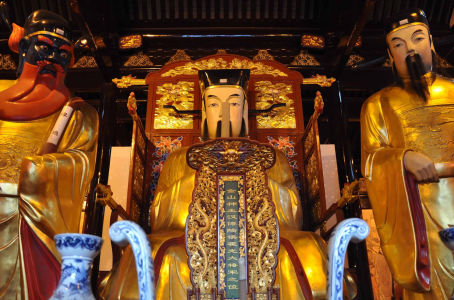
Old Man Under the Moon Hall
Among all halls within the temple, the Old Man Under the Moon Hall is easily the most beloved by young couples and romantic visitors. It enshrines the benevolent deity of marriage—the “Old Man Under the Moon,” holding a red string that binds destined lovers. Legend says those who pray sincerely here will be blessed with true love, which is why incense never ceases to burn. Locals often draw love fortunes or tie red strings inside the hall to seek harmony and lasting relationships. Whether or not you believe in divine matchmaking, stepping inside offers a warm sense of human hope and affection.
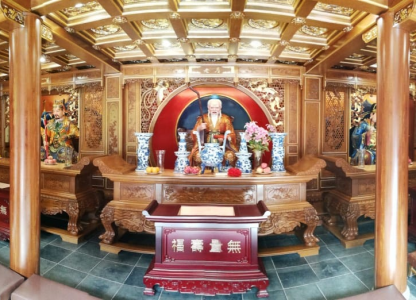
God of Wealth Hall
The God of Wealth Hall is perhaps the busiest and most fragrant spot in the entire temple. It houses statues of multiple wealth deities, including the Main God of Wealth, Inviting Wealth Immortal, Treasure-Bringing Immortal, Profit Immortal, and Precious Offering Immortal. The golden interior, decorated with murals symbolizing prosperity and abundance, glows in the flickering light of incense. During the Lunar New Year and business-opening seasons, countless merchants come here to pray for success and fortune. The lively yet spiritual scene reflects how faith and commerce harmoniously coexist in this modern city.

Guan Sheng Hall
The Guan Sheng Hall enshrines Guan Sheng Emperor (Guan Yu), the famed general of the Three Kingdoms era, honored as the God of Loyalty and the Martial God of Wealth. His imposing statue, gripping the Green Dragon Crescent Blade, radiates justice and bravery. Standing beside him are Generals Zhou Cang and Guan Ping, symbolizing devotion and filial piety. Many worshippers come not only to seek career blessings but also to reaffirm their own sense of integrity and righteousness amid life’s challenges.
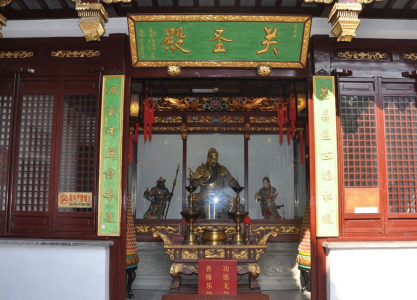
City God Hall
Passing through several courtyards leads you to the spiritual heart of the complex—the City God Hall. At its center sits the red-faced wooden statue of the City God of Shanghai, solemn and dignified. The hall replicates the setting of a Ming-dynasty county court, complete with ceremonial guards and official décor, representing the cosmic order that “Heaven has its justice, and Earth its City God.” As the divine guardian of the city, this deity oversees virtue, punishes evil, and protects Shanghai’s peace. The moment you enter, the blend of history, belief, and reverence surrounds you, revealing the moral core of old Shanghai’s spiritual life.
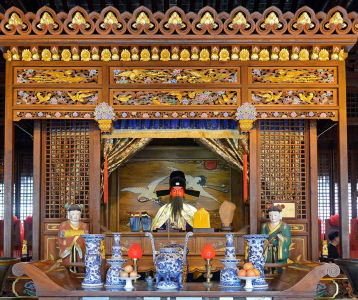
City God Temple Ticket Guide
Tickets for the City God Temple of Shanghai can only be purchased on-site by scanning the official WeChat QR code (see below). Payment is made directly through the app upon arrival.
- Price: 10 CNY, including three complimentary incense sticks. Once inside, you’ll find the incense distribution area near the entrance.
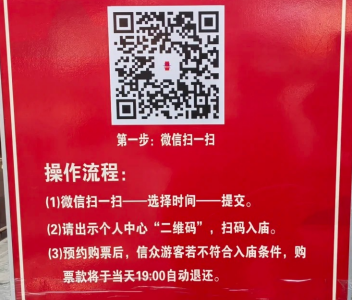
Recommended Visiting and Worship Route
- Upon entering, take your incense sticks and light them using the electric heaters on both sides of the square (many tourists mistakenly use open flames—be cautious ⚠️). Offer respect to the deities in all four directions.
- Begin at the Main Hall to pay homage to General Huo Guang. The temple is known as “One Temple, Two City Gods,” with Huo Guang honored in the front hall and Qin Yubo in the rear hall.
- Behind Huo Guang’s statue, bow before the image of Mazu, the Goddess of the Sea.
- Continue along the corridor to the Tai Sui Hall, where you can worship your personal Guardian Star and the ruling star of the year (each year is marked on copper plates along the wall).
- In the rear hall, pay respects to Guan Di on the left and Wenchang Star God on the right.
- Proceed to the City God Hall to worship the City God, his Lady, and the Holy Parents. Remember: “Front Hall for Huo, Rear Hall for Qin”—the latter honors Qin Yubo, the Ming official canonized as the City God of Shanghai.
- Beside the City God’s statue, two wooden boxes hold sacred fortune sticks. Each is carefully sealed; interpret your fortune online later, though true meaning comes from reflection.
- Finally, return to the front square to honor other domain-specific deities: the God of Wealth, Old Man Under the Moon, Medicine King, Car God, Cihang Zhenren (Guanyin), Eye Mother Goddess, and Mazu, among others.
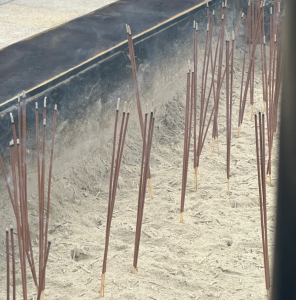
Recommended Food Near City God Temple
The area surrounding the City God Temple of Shanghai is a vibrant commercial zone filled with countless eateries and snack stalls. Prices tend to be higher due to heavy tourist traffic, but it’s a convenient place for a quick and satisfying meal. You can sample authentic Shanghai favorites such as scallion-oil noodles, steamed buns, green rice balls, and fried dumplings—all worth trying.
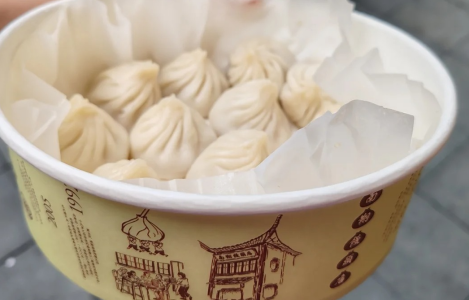
Recommended Hotels Near City God Temple of Shanghai
The best area to stay is near Nanjing West Road. From there, it’s easy to reach major attractions such as The Bund, the City God Temple, Yu Garden, Jing’an Temple, People’s Square, Tianzifang, and the Former Provisional Government of the Republic of Korea Site. Transportation to both airports—Pudong Airport and Hongqiao Airport—as well as to Hongqiao Railway Station and Shanghai Railway Station is extremely convenient. The Line 2 Metro from Nanjing West Road connects most popular spots and all major transport hubs, and the neighborhood offers plenty of dining and shopping options.
CitiGO Hotel Jingan Shanghai

- Location: 12-minute walk from Nanjing West Road Metro Station, 14-minute walk from Shanghai Natural History Museum Metro Station
- Price Range: 422 RMB
- Check Rates: Trip.com Specials, Compare on Klook
- Rating: Trip 4.8
- Special Amenities: Gym, laundry, robot room service
Very convenient, close to Nanjing West Road shopping district, easily accessible to other attractions. Be aware, there is another hotel with the same name nearby; double-check the address when taking a taxi.
Clean and well-equipped. Breakfast offers a wide variety, including fresh vegetables, fruits, delicious mousse, Swiss rolls, and freshly ground coffee. Free night snacks including dumplings available after 10 PM.
Ji Hotel (Shanghai People’s Square Nanjing Road)
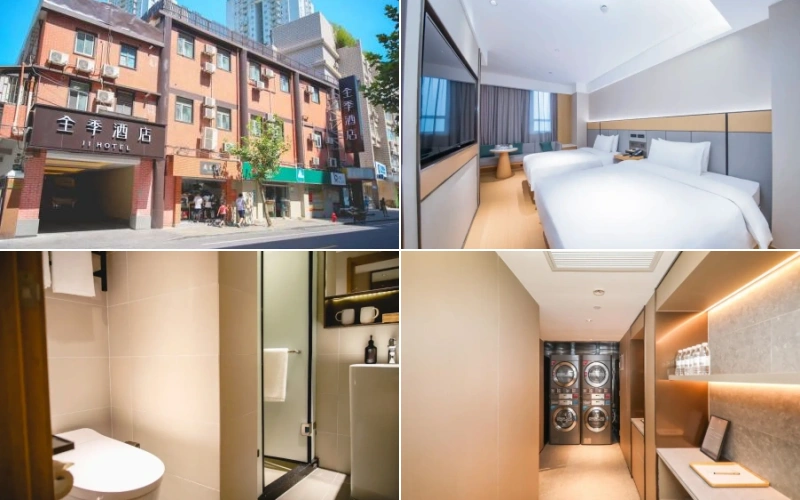
- Location: 9-minute walk from Huangpi South Road Metro Station, 10-minute walk from Nanjing West Road Metro Station
- Price Range: 487 RMB
- Check Rates: Trip.com Specials
- Rating: Trip 4.8
- Special Amenities: Laundry, robot room service, triple rooms
Located near People’s Square inside an old building, quiet, with easy access to transportation. Close to the Old Shanghai Museum, City God Temple, and local parks. Great value for money.
Excellent facilities, friendly and attentive staff. Rooms are clean, odor-free, and quiet. Varied breakfast options.
Atour Hotel X Nanjing West Road Shanghai
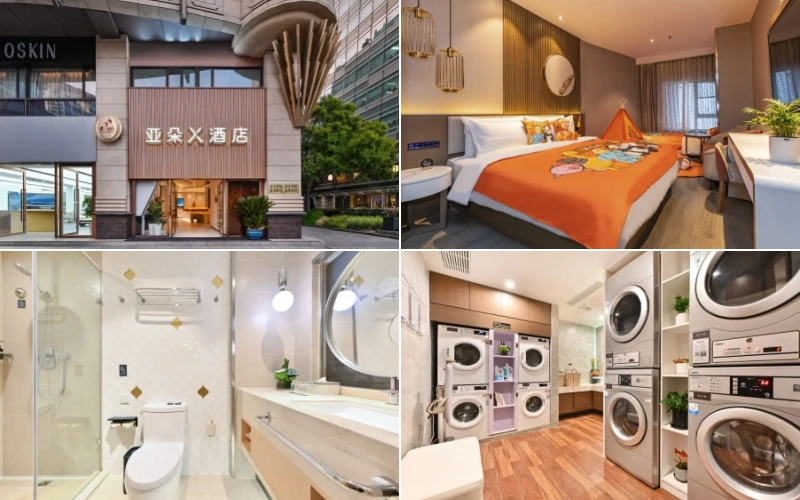
- Location: 7-minute walk from Nanjing West Road Metro Station, 9-minute walk from the Shanghai Natural History Museum Metro Station
- Price Range: 649 RMB
- Check Rates: Trip.com Specials, Compare on Klook
- Rating: Trip 4.8
- Special Amenities: Laundry, robot room service, triple rooms, family rooms
Prime location near Shanghai’s central business district, just below Wujiang Road, convenient for dining and close to a subway entrance.
Well-equipped, clean, and quiet. Features soft-bristled toothbrushes, excellent Wi-Fi, and high-pressure showers in the bathrooms with upscale fixtures.
How to Get to City God Temple of Shanghai from Downtown
The metro is highly recommended. The City God Temple of Shanghai sits in one of the city’s busiest tourist zones, where taxis often get stuck in traffic during rush hours. Taking the subway and walking the final ten minutes is usually faster.
Metro
Located on bustling Fangbang Middle Road, the temple is easily accessible via Metro Line 10 or Line 14 to Yu Garden Station. Use Exit 3 or 7 and follow the clearly marked signs. The fare is around 3 CNY, and the trip takes about 30 minutes.
Taxi / Ride-Hailing
If you prefer convenience, you can take a taxi directly to the temple. However, taxis in Shanghai are relatively expensive, and traffic can be heavy. A ride from downtown costs about 20 CNY and takes roughly 20 minutes.
FAQ
Not very convenient. Each main hall entrance has several steps, making it difficult for strollers or wheelchairs to pass through.
Luggage lockers are available near the metro station. You’ll find them close to Exit 5 of Yu Garden Station. If you can’t locate them, simply ask a metro staff member for assistance.
Essential Shanghai Travel Resources
- Comprehensive Shanghai Travel Guide 📖
- Shanghai Travel Recommendations 🏙️
- Hotel Recommendations 🏨
- Transportation Guides ✈️ 🚇 🚄 🚆
- Essential Travel Tips and Tools 🗺️ 🍜 📱 💸 🌤️ 💊🛍️🔌📶🧳
- 🗺️ Shanghai Maps
- 🍜 Shanghai Food and Dining Guide
- 🎁 Shanghai Souvenirs Guide
- 📱 Essential Travel Apps
- 💸 China Tax Refund Guide
- 🌤️ Shanghai Weather Guide
- 💊 Essential Medicines for Traveling
- 🛍️ Travel Deals China
- 🔌 China Plug Types and Power Adapter Guide
- 📶 How to Use eSIM China
- 🧳 Packing List and Travel Checklist

 English (US)
English (US)
 繁體中文
繁體中文 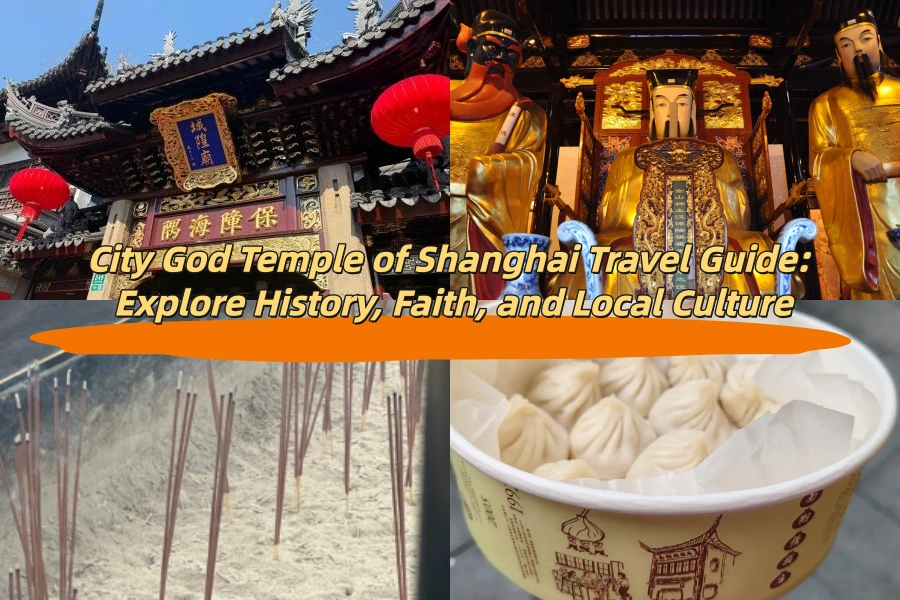
Comment (0)